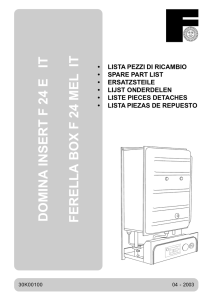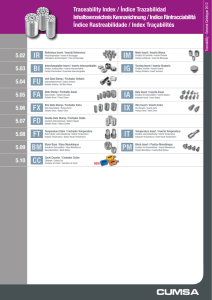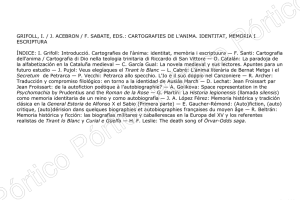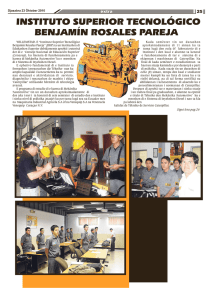Document
Anuncio
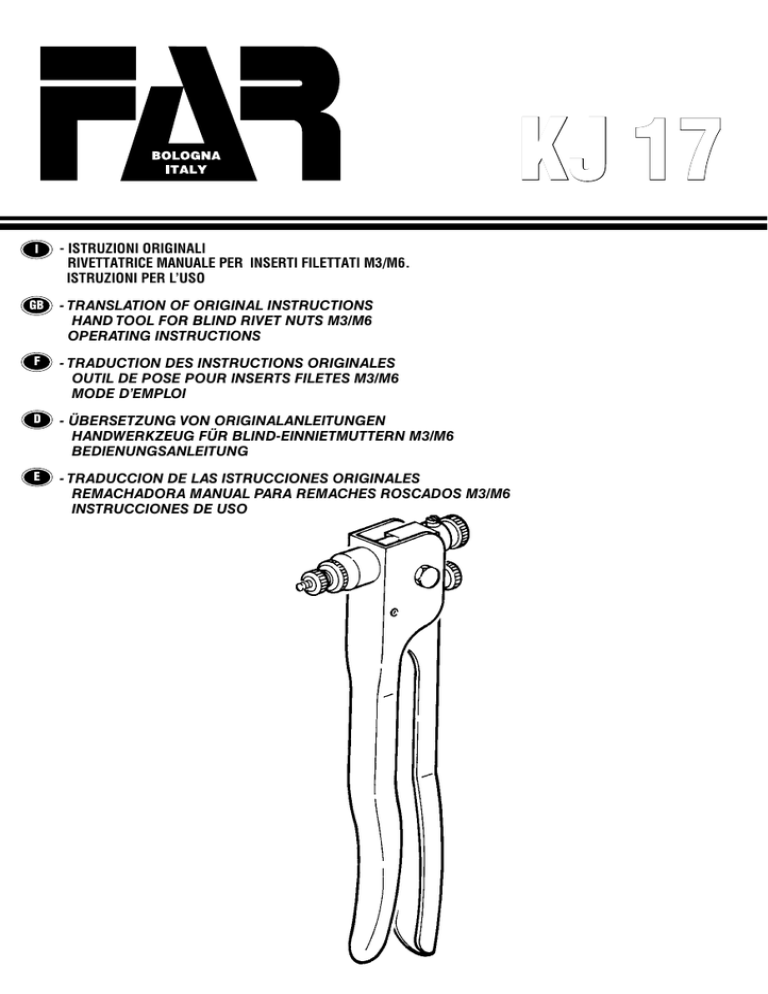
KJ 17 I GB - ISTRUZIONI ORIGINALI Rivettatrice manuale per inserti filettati M3/M6. ISTRUZIONI PER L’USO - TRANSLATION OF ORIGINAL INSTRUCTIONS Hand tool for blind rivet nuts M3/M6 OPERATING INSTRUCTIONS F - TRADUCTION DES INSTRUCTIONS ORIGINALES Outil DE POSE pour insertS FILETES M3/M6 MODE D’EMPLOI D - ÜBERSETZUNG VON ORIGINALANLEITUNGEN Handwerkzeug für Blind-Einnietmuttern M3/M6 BEDIENUNGSANLEITUNG E - TRADUCCION DE LAS ISTRUCCIONES ORIGINALES REMACHADORA MANUAL PARA REMACHES ROSCADOS M3/M6 INSTRUCCIONES DE USO 1 2 3 4 h 5 h 0,5 mm 1 2 6 Italiano Rivettatrice manuale per l'utilizzo di inserti filettati con filettatura da M3 a M6. Prima dell'utilizzo accertarsi che la coppia tirante - testina montata sulla rivettatrice sia adeguata alla filettatura dell'inserto che si vuole serrare,in caso contrario occorre procedere al cambio di formato. Attenzione: Solitamente la coppia tirante-testina montata sulla rivettatrice in confezione corrisponde ad una filettatura di M6. Cambio di formato: Svitare e togliere la testina (1) e la ghiera (2) Allentare la vite (3) ed estrarre il tirante (4) ;sostituirlo sciegliendo dal kit di corredo la misura necessaria.Ogni rivettatrice è corredata di un tirante ed una testina per ogni formato di inserto, la ghiera (2) viene invece utilizzata con tutti i formati. REGOLAZIONE DELLA CORSA: Questa operazione deve essere eseguita prima della messa in opera dell'inserto, in funzione dello spessore del materiale da serrare. La regolazione si ottiene intervenendo sul pomello di registro (5) svitandolo per aumentare la corsa e avvitandolo per diminuirla. Aumentando la corsa si ottiene una maggiore deformazione dell'inserto con conseguente diminuzione della distanza (h) tra la testa dell'inserto e la sua deformazione. Al contrario diminuendo la corsa la distanza (h) aumenterà a causa della minore deformazione. Eseguita la prima regolazione di massima fissare l'inserto sul materiale e rifinire la regolazione della corsa in base alla stretta che l'inserto opera sul materiale.La corsa ottimale è quella che permette un saldo, ma non esasperato, serraggio dell'inserto sul materiale: in caso di corsa ridotta si rischia il non perfetto bloccaggio ,in caso opposto ,cioè corsa troppo "ampia" ,si rischia la deformazione del filetto. REGOLAZIONE DELLA testina: Una volta definita la corsa regolare la testina (1) in modo che il tirante faccia presa su tutti i filetti dell'inserto. Avvitare sul tirante l'inserto filettato in modo che la sua testa vada a battuta con la testina della rivettatrice. Verificare che il tirante fuoriesca di circa 0,5 mm dall'inserto ,in caso contrario sbloccare la ghiera (2) e registrare la posizione della testina: avvitandola aumenterà la sporgenza del tirante,svitandola la sporgenza del tirante diminuirà; ad operazione ultimata ribloccare la ghiera(2). Le operazioni di regolazione descritte devono essere sempre ripetute quando avviene il cambio di formato. Serraggio dell'inserto: Avvitare l'inserto sul tirante, posizionarlo nel foro praticato sul materiale e serrarlo tramite l'azione della leva (6). Ad operazione ultimata svitare il tirante: la rivettarice è pronta per il serraggio di un nuovo inserto. English Hand tool for blind rivet nuts from M3 to M6. Before using it, make sure that the stay bolt and the head assembled on the tool are suitable for the thread of the insert to be used; otherwise, it will be necessary to change the stay bolt and the head size. Warning: The standard stay bolt and head supplied with the tool is usually M6. SIZE CHANGE: Unscrew the head ( 1 ) and the ring nut ( 2 ). Loosen the screw ( 3 ) and take out the stay bolt ( 4 ); replace it by choising the correct size from the kit. Each tool is equipped with a stay bolt and a head for each size, the ring nut ( 2 ) can be fitted with any insert size. STROKE ADJUSTMENT: By unscrewing the knob ( 5 ) the stroke will increase; by screwing the knob ( 5 ) the stroke will be reduced. By increasing the stroke, the insert deformation will be greater and therefore, the ( h ) distance from the insert head and its deformation, will be reduced. By reducing the stroke, the ( h ) distance will increase because of the smaller deformation. When the preliminary adjustment has been made, the insert can be fixed on the material to clamp; complete the stroke in accordance with the pressure that the insert needs for the material. In case of reduced stroke, the insert will not be properly locked, otherwise, in case of wider stroke, the thread will be deformed. HEAD ADJUSTMENT: After having set the stroke, it is necessary to adjust the head ( 1 ). Put the threaded insert on the stay bolt; it is very important that the head of the insert is fully located. The stay bolt must come out by 0,5 mm from the insert, if this doesn't happen, it is necessary to unlock the ring nut (2) and adjust the head position: by screwing it, the extention of the stay bolt will increase; by unscrewing it, the extention of the stay bolt will be reduced. After that you can lock again the ring nut ( 2 ). Every time the insert size is changed this adjustment is always necessary. INSERT OPERATION: Screw the insert on the stay bolt; position it in the hole of the material and pull the insert by the levers ( 6 ). After that, unscrew the stay bolt: now the tool is ready for a new insert. Espãnol REMACHADORA MANUAL PARA LA UTILIZACION DE REMACHES ROSCADOS CON FILETEADURA de M3 A M6. Antes de utilizarla asegurarse que la pareja tirante - cabeza montada sobre la remachadora sea adecuada a la fileteadura del remache que se desea ajustar, en caso contrario se debe proceder al cambio de formato. Atencion: Normalmente la pareja tirante - cabeza montada sobre la remachadora de fábrica corresponde a una fileteadura de M6. Cambio dE formato: Destornillar y quitar la cabeza ( 1 ) y la virola ( 2 ). Aflojar el tornillo ( 3 ) y extraer el tirante ( 4 ); sostituirlo eligiendo del kit de fábrica la medida necesaria. Cada remachadora es abastecida de un tirante y una cabeza para cada formato de remache, la virola ( 2 ) es utilizada para todos los formatos. REGULACION DE LA CARRERA: Esta operación debe ser realizada antes de la puesta en obra del remache, en función del espesor del material a ajustar. La regulación se obtiene interviniendo sobre el pomo de registro ( 5 ) desenroscandolo para aumentar la carrera y enroscandolo para disminuirla. Aumentando la carrera se obtiene una mayor deformación del remache con consiguiente disminución de la distancia ( h ) entre la cabeza del remache y su deformación. Al contrario disminuyendo la carrera la distancia ( h ) aumentará a causa de la menor deformación. Realizada la primera regulación de máxima fijar el remache sobre el material y terminar la regulación de la carrera en base al apretamiento que el remache ejerce sobre el material. La carrera optima es aquella que permite un firme, pero no exasperado, ajuste del remache sobre el material: en caso de carrera reducida se corre el riesgo de un imperfecto ajuste, en caso opuesto, o sea carrera muy " amplia ", se corre el riesgo de una deformación en el filete. REGULACION DE LA CABEZA: Una vez definida la carrera regular la cabeza ( 1 ) en modo que el tirante haga toma sobre todos los filetes del remache Atornillar sobre el tirante el remache roscado en modo que su cabeza vaya a golpe con la cabeza de la remachadora. Verificar que el tirante sobresalga aproximadamente 0,5 mm del remache, en caso contrario desbloquear la virola ( 2 ) y registrar la posición de la cabeza: atornillandola aumentará la parte que sobresale del tirante, desenroscandola la parte sobresaliente del tirante disminuirá; con la operación terminada bloquear nuevamente la virola ( 2 ). Las operaciones de regulación descriptas deben ser siempre repetidas cuando se realiza el cambio de formato. AJUSTE DEL REMACHE: Atornillar el remache sobre el tirante, posicionarlo en la perforación practicada sobre el material y ajustarlo a través de la palanca ( 6 ). Con la operación terminada desenroscar el tirante: la remachadora está lista para el ajuste de un nuevo remache. Française Outil manuel pour l'utilisation d'inserts de M3 à M6. Avant l'emploi vérifier que l'ensemble tirant-tête, monté sur l'outil, soit approprié au filetage de l'insert que l'on veut serrer. Au cas contraire, il faut pourvoir au changement de diamètre. Attention: d'habitude l'ensemble tirant-tête assemblé sur l'outil dans le coffret correspond à un filetage de M6. CHANGEMENT DE DIAMETRE: Dévisser la tête ( 1 ) et l'embout ( 2 ). Desserrer la vis ( 3 ) et enlever le tirant ( 4 ); remplacer le tirant en choisissant la dimension nécessaire dans le kit. Tous les outils sont livrés avec un tirant et une tête dans chaque diamètre d'insert. L'embout ( 2 ) est employé pour tous les formats. REGLAGE DE LA COURSE: Dévisser la vis de réglage ( 5 ) pour augmenter la course et visser pour la réduire. En augmentant la course,l'insert subira une déformation plus importante et la distance ( h ) entre la tête de l'insert et sa déformation subira un écrasement. Au cas contraire, en réduisant la course, la distance ( h ) augmentera à cause de la déformation inférieure. Une fois que l'on a fait le réglage préliminaire, il faut fixer l'insert sur la pièce et ajuster la course en contrôlant le serrage de l'insert sur l'épaisseur. Au cas où la course est réduite, on risque un blocage incorrect; au cas contraire, c'est-à-dire quand la course est trop grande, on risque une déformation du filet. REGLAGE DE LA TETE: Après le réglage de la course on peut régler la tête ( 1 ). Visser l'insert fileté sur le tirant jusqu'au contact de l'insert avec la tête de l'outil. Vérifier que le tirant sorte de l'insert de 0,5 mm; au cas contraire, débloquer l'embout ( 2 ) et régler la position de la tête: en la vissant pour augmenter, ou en dévissant pour diminuer la sortie du tirant. Après avoir effectué cette opération, bloquer l'embout ( 2 ). Les opérations citées ci-dessus doivent toujours être répétées quand on change de diamètre ou de longueur d'insert. SERRAGE DE L'INSERT: Après avoir vissé l'insert sur le tirant, on doit le positionner dans le trou percé sur le matériel et serrer le levier ( 6 ). A la fin de l'opération, dévisser le tirant. L'outil est prêt pour serrer un nouvel insert. Deutsch HandNIET GERATE für Benutzung von BlindEINnietmuttern von M3 bis M6. Vor Gebrauch, nachsehen ob die zwei Teile Zugbolze-Kopf, die auf dem Werkzeug montiert sind, zur Blindnietmutter-Gewinde, die man klemmen will, passen. Wenn es nicht den Fall ist, muss man den richtigen Durchmesser auswählen. Achtung: Normalerweise ist das Paar " Zugbolze-Kopf " auf dem Werkzeug in M6 montiert. DURCHMESSERWECHSEL: Kopf ( 1 ) und Ansatz ( 2 ) abschrauben. Die Schraube ( 3 ) lockern und den Zugbolzen ( 4 ) wegnehmen; der Zugbolzen wird gewechselt in dem man die richtige Dimension aus dem Kit heraus nimmt. Alle Werkzeuge sind mit Zugbolzen und Köpfe von jedem Durchmesser geliefert. Den Ansatz ( 2 ) ist für alle Grössen verwendbar. KURSUSREGULIERUNG: Regulierschraube ( 5 ) lockern für den Kursus steigern und schrauben um ihn verkleinern. Wenn man den Kursus steigert, erträgt die Blindnietmutter eine grössere Verzerrung und die Distanz ( h ) zwischen dem Kopf der Blindnietmutter und seine Verzerrung erträgt eine Quatschung. Im Gegenteil, wenn man den Kursus reduziert, wird die Distanz ( h ) grösser wegen der unteren Verzerrung. Wenn die Vorregulierung eingestellt ist, muss man die Blindnietmutter auf das Stück setzen und Kursus anpassen in dem man den Kursus von der Blindnietmutter mit der Dicke kontrolliert. Im Falle der Kursus reduziert ist, riskiert man eine schlechte Blockierung; im Gegenteil, d.h. wenn der Kursus zu gross ist, riskiert man eine Gewinde-verzerrung. KOPF EINSTELLUNG: Nach der Kursus-Einstellung kann man den Kopf einstellen. Die Blindnietmutter auf den Zugbolzen schrauben bis Kontakt mit dem Kopf des Werkzeuges. Prüfen dass der Zugbolze von 0,5 mm aus der Blindnietmutter rausschaut; wenn es nicht den Fall ist, den Ansatz ( 2 ) deblockieren. Dann die Kopfstellung einstellen per Schraubung für steigern, oder abschrauben für verringern um den Zugbolze heraus zu machen. Nach diesem Vorgang, den Ansatz blockieren ( 2 ). Dieser Vorgang muss immer wiederholt werden wenn Grösse oder Länge von Blindnietmutter gewechselt werden. BLINDNIETMUTTERKLEMMUNG: Nachdem man die Blindnietmutter auf den Zugbolzen geschraubt hat, muss man die Blindnietmutter in das gebohrenes Loch einlegen und den Hebel ( 6 ) pressen. Am Ende diesem Vorgang, den Zugbolzen abschrauben. Das Werkzeug ist für eine neue Blindnietmutter zur Schraubung parat. PARTI DI RICAMBIO • SPARE PARTS • PIECES DETACHEES • ERSATZTEILE • PIEZAS DE REPUESTO 6 7 8 2 14 12 A 3 9 1 15 19 A 16 4 18 10 B 17 12A(x1) 11 B 13 5A 20 11B(x1) 19A(x1) 5A(x1) KIT A 10B(x1) KIT B N° COD. Qt. DESCRIZIONE DESCRIPTION DESCRIPTION 01 02 03 04 05A 06 07 08 09 10B 11B 12A 13 14 15 16 17 18 19A 20 721509 711510 711512 712287 711514 721516 721517 721518 721519 710135 710136 710137 710144 710145 710146 710147 710148 710149 710048 711521 1 1 1 1 1 1 1 1 1 1 1 1 1 1 1 1 1 1 1 1 Leva principale Leva secondaria Corpo Perno Vite TE M7 x 33,5 Tirante M 3 Tirante M 4 Tirante M 5 Tirante M 6 Molla ritorno leve Perno filettato Vite TCCI M5 x 5,3 Ghiera Testa M 3 Testa M 4 Testa M 5 Testa M 6 Pomello Dado M 7 UNI 5589 Spina elastica ø 4 x 28 UNI 6873 Principal lever Secondary lever Body Roll pin Screw TE M7 x 33,5 Tie rod M 3 Tie rod M 4 Tie rod M 5 Tie rod M 6 Spring for lever return Threaded pin Screw TCCI M5 x 5,3 Ring nut Head M 3 Head M 4 Head M 5 Head M 6 Knob Nut M 7 UNI 5589 Spring pin ø 4 x 28 UNI 6873 Levier principal Levier secondaire Corps Pivot Vis TE M7 x 33,5 Tirant M 3 Tirant M 4 Tirant M 5 Tirant M 6 Ressort retour leviers Pivot filete Vis TCCI M5 x 5,3 Bague Tête M 3 Tête M 4 Tête M 5 Tête M 6 Bouton Ecrou M 7 UNI 5589 Goupille élastique ø 4 x 28 UNI 6873 Haupthebel Zweithebel Körper Stift Schraube TE M7 x 33,5 Gewindedorn M 3 Gewindedorn M 4 Gewindedorn M 5 Gewindedorn M 6 Feder Rücklauf Hebel Gewindestift Schraube TCCI M5 x 5,3 Nutmutter Kopfteil M 3 Kopfteil M 4 Kopfteil M 5 Kopfteil M 6 Knopf Mutter M 7 UNI 5589 Spannstift ø 4 x 28 UNI 6873 BESCHREIBUNG KIT KITA 05A 12A 19A 741514 711514 1 710137 1 710048 1 Kit Vite M 7 Vite TE M7 x 33,5 Vite TCCI M5 x 5,3 Dado M 7 UNI 5589 Screw M 7 kit Screw TE M7 x 33,5 Screw TCCI M5 x 5,3 Nut M 7 UNI 5589 Kit vis M 7 Vis TE M7 x 33,5 Vis TCCI M5 x 5,3 Ecrou M 7 UNI 5589 Kit Schraube M 7 Schraube TE M7 x 33,5 Schraube TCCI M5 x 5,3 Mutter M 7 UNI 5589 Kit Perno Molla ritorno leve Perno filettato Pin kit Spring for lever return Threaded pin Kit pivot Ressort retour leviers Pivot filete Kit Bolzen Feder Rücklauf Hebel Gewindestift Indica che il particolare viene venduto in Kit composti da particolari diversi in quantità diverse. It indicates that the part is sold in kits consisting of different parts in different quantities. Indique que la pièce est vendue dans des KITS composés de diverses pièces dans des quantités différentes. Dieses Wort gibt an, daß der Teil in KIT von verschiedenen Teilen in unterschiedlichen Mengen verkauft wird. A B B A A KIT KITB 740136 10B 710135 1 11B 710136 1 KIT GB The list of the service centres is available on our website http://www.far.bo.it ( Organization ) F La liste des centres d’assistance est disponible sur notre site internet http://www.far.bo.it ( Organisation ) D Die Liste der Reparaturservices ist verfügbar unter unserer Webseite http://www.far.bo.it ( Organisation ) E La lista de los servicios postventa es disponible en nuestro sitio web http://www.far.bo.it ( Organización ) PL Lista punktów serwisowych jest dostępna na naszej stronie internetowej http://www.far.bo.it ( Organizacja ) RUS Список сервисных центров приведен на нашем веб-сайте http://www.far.bo.it ( ОРГАНИЗАЦИЯ ) SISTEMI DI FISSAGGIO FASTENING SYSTEMS • SYSTEMES DE FIXATION VERBINDUNGSSYSTEME • SISTEMAS DE FIJACION SYSTEMY MOCOWANIA • СИСТЕМЫ КРЕПЛЕНИЯ SEDE • HEAD OFFICE • SIEGE HAUPTSITZ • SEDE SIEDZIBA • ОФИСНЫЙ ЦЕНТР : DEPOSITO • WAREHOUSE • DEPOT WARENLAGER • ALMACEN ODDZIAŁ • СКЛАД : 40057 Quarto Inferiore - Bologna - Italy Via Giovanni XXIII, 2 Tel. +39 - 051 6009511 Ufficio Vendite Fax +39 - 051 767443 E-mail: [email protected] Export Dpt. Fax +39 - 051 768284 E-mail: [email protected] 20099 Sesto San Giovanni Milano Italy Via Archimede, 8 Tel. +39 - 02 2409634 Fax +39 - 02 26222279 E-mail: [email protected] www.far.bo.it Revision - 02 L’elenco dei centri di assistenza è disponibile sul Ns. sito web: http://www.far.bo.it ( Organizzazione ) Date 10-2010 I
